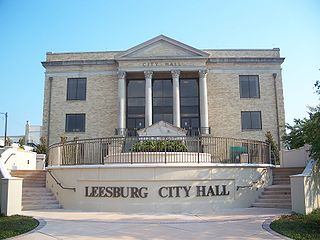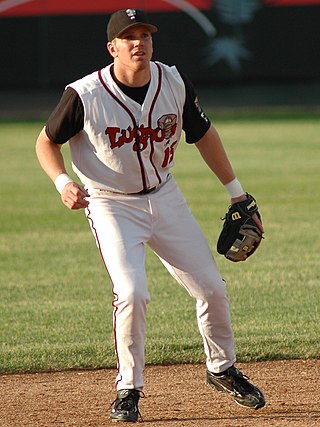Related Research Articles


Leesburg is a city in Lake County, Florida, United States. The population was 20,117 at the 2010 census. As of 2019, the population recorded by the U.S. Census Bureau was 23,671.

The Villages is a census-designated place (CDP) in Sumter and Marion counties in the U.S. state of Florida. It shares its name with a broader master-planned age-restricted community that spreads into portions of Lake County. The overall development lies in central Florida, approximately 20 miles (32 km) south of Ocala and approximately 45 miles (72 km) northwest of Orlando. As of the 2020 census, the population of the CDP was 79,077.

Jonathan May was an American cellist and conductor. He resided in the Orlando, Florida area and was noted for founding and directing numerous youth orchestras and music programs throughout the region.
Lake Highland Preparatory School is a private, coeducational school in Orlando, Florida. It is the largest private school in Orlando and the fourth-largest private school in the state. It serves grades pre-K through 12, separated into lower, middle, and upper schools.

Lake–Sumter State College is a public college with multiple campuses in Central Florida: three campuses in Lake and Sumter Counties; the original campus in Leesburg; the South Lake Campus in Clermont; and the Sumter Campus in Sumterville. It is a member of the Florida College System. The college also partners with The Villages Charter High School as a dual enrollment site.

Leesburg High School is a public high school located in Leesburg, Florida and is one of seven public high schools in Lake County, Florida. The school is made up of approximately 1,500 students. The current principal is Michael Randolph.

Lake Nona is a 17-square-mile mixed-use planned community within the city limits of Orlando, southeast of Orlando International Airport. Being developed by Lake Nona Property Holdings, the Lake Nona Region is home to Lake Nona Golf & Country Club.
Suwannee River Junior College, located in Madison, Florida, opened in 1959. It was one of eleven black junior colleges founded in the late 1950s at the initiative of the Florida Legislature. Since racial integration in schools was prohibited in the Florida Constitution of 1885 then in effect, the Legislature wished to avoid the integration mandated in the unanimous Brown v. Board of Education Supreme Court decision of 1954 by demonstrating that a "separate but equal" higher education system existed in Florida for African Americans.
Roosevelt Junior College was an institution serving African-American students, located on an 18-acre campus at 1235 Fifteenth Street in West Palm Beach, Florida. It took its name from the adjacent black Roosevelt High School, named in honor of former U.S. President Theodore Roosevelt.
Booker T. Washington Junior College, the first and longest-lasting junior college for African Americans in Florida, was established by the Escambia County school board in 1949. Previously, the only higher education available in Florida to African Americans was at Bethune-Cookman College, Edward Waters College, Florida A&M University, and Florida Memorial College, all historically black.
Gibbs Junior College was created in 1957 by the Pinellas County Board of Public Instruction to serve African-American students in St. Petersburg, Florida. It was the first and most successful of Florida's eleven new African-American junior colleges, founded in an unsuccessful attempt to avoid the racial integration mandated by the unanimous 1954 Supreme Court Brown v. Board of Education decision. It was named for the minister and abolitionist Jonathan C. Gibbs, who opened a private school for freed slaves after the Civil War, and was later Florida's Secretary of State (1868–1872) and then Superintendent of Public Instruction, the first African-American member of the Florida Cabinet.
Carver Junior College, in Cocoa, Florida, was established by the Brevard County Board of Public Instruction in 1960 to serve black students, at the same time that it founded Brevard Junior College, now Eastern Florida State College, for white students. It was named for the black agricultural researcher George Washington Carver. Like 10 of Florida's other 11 black junior colleges, it was founded as a result of a 1957 decision by the Florida Legislature to preserve racial segregation in education, mandated under the 1885 Constitution that was in effect until 1968. More specifically, the Legislature wanted to show, in response to the unanimous Supreme Court decision mandating school integration, that the older standard of "separate but equal" educational facilities was still viable in Florida. Prior to this legislative initiative, the only publicly funded colleges for negro or colored students were Florida A&M University, in Tallahassee, and Booker T. Washington Junior College, in Pensacola.
Hampton Junior College, located in Ocala, Florida, opened its doors in 1958. It was one of eleven black community colleges which were founded, at the urging of the Florida Legislature, to show that a "Separate but equal" educational system for blacks existed in Florida; the Legislature wished to avoid the integration mandated by the Supreme Court's Brown v. Board of Education decision of 1954. At the time, the closest public college that would accept negroes was Florida A&M University, 175 miles away.
Collier-Blocker Junior College, located at 1100 N. 19th Street in Palatka, Florida, opened its doors in 1960. It was one of eleven black junior colleges founded in the late 1950s at the initiative of the Florida Legislature. Since racial integration in schools was prohibited in the Florida Constitution of 1885 then in effect, the Legislature wished to avoid the integration mandated in the unanimous Brown v. Board of Education Supreme Court decision of 1954 by demonstrating that a "separate but equal" higher education system existed in Florida for African Americans.
Lincoln Junior College, located in Fort Pierce, Florida, opened its doors in 1960, at the same time as Indian River Junior College, restricted to white students. It was designed to serve Indian River, Martin, Okeechobee, and St. Lucie counties. It was one of eleven black community colleges which were founded, at the urging of the Florida Legislature, in the late 1950s and early 1960s to show that a "separate but equal" educational system for blacks existed in Florida; the Legislature wished to avoid the integration mandated by the Supreme Court's Brown v. Board of Education decision of 1954. At the time, there was no nearby college for Negroes, while the distances and lack of funding effectively closed off most local blacks from college.

The Lake County Public Library System (LCLS) is a library system located in Lake County, Florida.

Ryan P. Klosterman is an American baseball coach and former shortstop. He is the head baseball coach at Bryant University. Klosterman played college baseball at Clemson University in 2001 and at Vanderbilt University from 2002 to 2004 for coach Tim Corbin and in Minor League Baseball (MiLB) for eight seasons from 2004 to 2011.
Carver Heights High School was a segregated public school for black students in Leesburg, Florida. It briefly served as the site of segregated Johnson Junior College as well. It was closed when the schools were integrated.
References
- ↑ "The History of LSCC", http://www.lssc.edu/about/Pages/History.aspx, retrieved May 8, 2016.
- ↑ Walter L. Smith, The Magnificent Twelve: Florida's Black Junior Colleges, Winter Park, Florida, FOUR-G Publishers, 1994, ISBN 1885066015, p. 243.
- ↑ Smith, p. 226.
- ↑ Smith, p. 248.
- 1 2 McCarthy, Kevin (1995). Black Florida. New York: Hippocrene Books. ISBN 0-7818-0291-1.
- ↑ Smith, p. 243.
- ↑ Smith, pp. 252-253.
- ↑ Smith, p. 263.
- ↑ "The History of LSCC", http://www.lssc.edu/about/Pages/History.aspx, retrieved May 8, 2016.
- ↑ Rick Badie, "Devotion To Education For Blacks Lives On. The Memory Of Two Black Educators Is Being Kept Alive On The Leesburg Campus Of Lake-Sumter Community College", Orlando Sentinel , February 20, 1996, http://articles.orlandosentinel.com/1996-02-20/news/9602190855_1_lake-sumter-johnson-lake-and-sumter, retrieved May 8, 2016.
- ↑ Smith, p. 251.
- ↑ Smith, p. 249.
- ↑ Rick Badie, "Devotion To Education For Blacks Lives On. The Memory Of Two Black Educators Is Being Kept Alive On The Leesburg Campus Of Lake-Sumter Community College", Orlando Sentinel , February 20, 1996, http://articles.orlandosentinel.com/1996-02-20/news/9602190855_1_lake-sumter-johnson-lake-and-sumter, retrieved May 8, 2016.
- ↑ Smith, p. 248.
- ↑ "A Look at Carver Middle School's Rich Heritage", http://www.lake.k12.fl.us/domain/1984, retrieved May 8, 2016.
- ↑ Smith, p. 254.
- ↑ Smith, p. 264.
- ↑ Smith, p. 257.
- ↑ Smith, p. 258.
- ↑ Kevin M. McCarthy, African American Sites in Florida, Pineapple Press, 2007, ISBN 1561643858, p. 117.
- ↑ Rick Badie, "Devotion To Education For Blacks Lives On. The Memory Of Two Black Educators Is Being Kept Alive On The Leesburg Campus Of Lake-sumter Community College", Orlando Sentinel , February 20, 1996, http://articles.orlandosentinel.com/1996-02-20/news/9602190855_1_lake-sumter-johnson-lake-and-sumter, retrieved May 8, 2016.